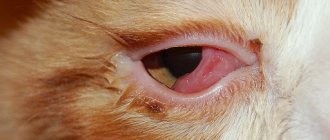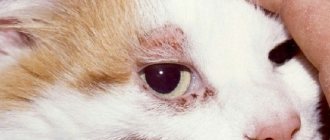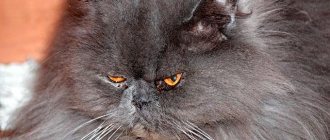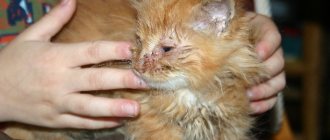The first months of a kitten's life are characterized by rapid growth. For a kitten, this is a time of discovery and awakening. For their human caregiver, this is a time of both joy in this new life and concern for them getting the best start. In cases where we think that the kitten is not growing as quickly as it should, this problem can become acute. A kitten's vulnerability makes it especially susceptible to parasites and disease. Improper feeding can also hinder their development. However, there are various reasons why a kitten is not growing.
This article looks at these reasons as to why a kitten is not growing. We explain why a cat may not develop and what to do about it.
When do kittens stop growing?
While we need to be sensitive to any cause of growth failure in cats, we can only do so if we know what normal growth looks like. This means exploring the context of adoption in your family. It's important to know as much as you can about how to prepare for a cat entering your home. This means knowing specific information about the breed as well as their basic care needs.
Some of the reasons why a kitten may not be growing include:
- Their breed
- Nutrient deficiencies
- Parasites
- Disease
- Dwarfism
It is possible to adopt a cat of an unknown breed. We may bring home strays or adopt them from a shelter, which may mean we don't necessarily know the breed. They may also be of mixed origin. Some breeds are larger than others, and some are smaller. For example, if you previously adopted a Maine Coon but then adopted a Persian kitten, you may think that the latter is not developing properly. In contrast, the breed is known to be smaller.
© shutterstock
Perhaps the smallest breed is the Munchkin cat. This is a breed that encourages the genetic trait of short legs. The result was a short-legged breed with a long body. If you have a munchkin kitten, he may stop growing, but his development is relatively normal. Even when they are grown, they look like adult cats that look like kittens.
Not all kittens in a litter will be uniform. They will likely vary in size and appearance. Some litters will have a kitten that is especially small and weak. They are called shorties. Runts are at a severe disadvantage because they are not as well developed and cannot compete for resources with their littermates. The mother may even reject them, although they are usually only eaten if they are too weak to survive.
Shorties may be poorly developed at first and grow more slowly than their littermates. This doesn't mean they can't grow up to be happy, healthy adult cats. This may require us to take over the responsibilities of feeding and raising them if the mother rejects them or they cannot feed enough.
For all of the above reasons, it is important to know when a kitten will stop growing. While different breeds will vary, so will individuals. However, if the cat is healthy, has been fed properly and does not have any specific medical conditions, it should naturally stop growing between 9 and 12 months.
How tall is the cat?
In this image you can see the size of the cat with 1 day, 10, 3 weeks, 5, 8, 14, 5 months and a year. Image – Warren Photography
In the image above you can see how the cat is growing. Although, of course, this is indicative. Large breeds such as the Maine Coon can take two years to reach their full size.
Why isn't my kitten growing?
Once you can determine if your cat is indeed growing at a slow rate, we need to look at the causes that can be avoided. So far we have talked about kittens remaining with their mother. However, we may have an adopted kitten who appears short and on his own. One of the reasons for this is premature departure from the mother.
Kittens should remain with their mother for a minimum of 8 weeks, ideally 12. This time allows the cat to obtain essential nutrients from the mother's milk, as well as to be properly socialized and eventually transition to solid food. If this does not happen, they may suffer from developmental deficiencies. However, if they are well fed, their physical problems should not be significant.
The reasons why a kitten is not growing are most likely due to health problems. Because they are at one of the most vulnerable stages of their lives, they are at greater risk of disease and parasitic infestations. When a mother cat gives birth, she will need to find a safe, quiet and clean place. If their nesting site is infested with parasites, an infestation is likely.
Some parasitic infestations are also asymptomatic. This means that the parasite may be present, but there are no visible signs. When this occurs in a pregnant mother, the parasites can be passed on to the kittens through nursing. Vulnerable kittens do not yet have the immunity to fend off their effects like their mother does. As a result, they stop growing.
Hygiene is also a factor in viral and bacterial infections. If there are bacteria or germs around the nesting site or in the kitten's environment, they are more susceptible to infection. This is why it is so important to closely monitor kittens. If we see signs of malnutrition, vomiting or diarrhea, these are signs that something is wrong in their development. If they continue to be ignored, stunted growth may result.
Because nutrition is so important at this stage of a kitten's life, a poor or insufficient diet can slow growth. Mother's milk should be enough, but if we feed them on our own or after weaning we haven't had enough food, it can lead to problems. If we are trying to feed kittens homemade food, proper nutrition is very important. Because cats are obligate carnivores, attempting to feed them a vegetarian or vegan diet can also cause severe developmental problems.
What to do after forty
After forty, hormonal changes become the main cause of coxarthrosis, gonarthrosis and arthrosis of the hand. With the onset of menopause in women, the situation worsens, especially in the area of the fingers. The level of estrogen in the body decreases - it begins to actively lose moisture, including in the joint. Cartilage experiences a moisture deficiency, becomes brittle and vulnerable.
At this age, it is especially important to lead a healthy lifestyle - just being in the fresh air and giving up bad habits. The condition of joints and cartilage tissue depends on the style of nutrition, the supply of oxygen and vitamins.
Genetic and pathological causes
Although poor nutrition or the presence of parasites may explain why a kitten is not growing, there are a few rare reasons why a kitten may be short. The kitten may be born healthy. Since they have not yet been developed, it can be difficult to determine if they are underdeveloped. After a few weeks, we will be able to better understand whether their growth is actually stunted.
© shutterstock
It is also easier to determine a kitten's growth rate if it stays with its littermates. By comparing a kitten with its siblings, we can tell if there are problems with their growth. If so, they may have one of the following conditions:
- Congenital hypothyroidism : The thyroid gland is a gland that helps control a cat's metabolic rate by secreting hormones.
- Mucopolysaccharidosis : is a term for a number of diseases that are caused by enzyme deficiencies.
- Pituitary dwarfism : This is a condition caused by a deficiency of growth hormone.
- Portosystemic shunt: In this case, there is a circulatory problem that prevents the body from processing toxins properly.
What is arthrosis of the hand
The joint contains cartilage tissue, which for one reason or another changes. Defective areas form on it. They become thinner and bone growths (osteophytes) appear. Fingers acquire a characteristic unaesthetic lumpiness, which makes it difficult to perform familiar actions that require fine motor skills.
Neither arthrosis of the hands nor gonarthrosis are inherited: only a predisposition to it is transmitted. You can inherit metabolic characteristics, the nature of the tissues, the elasticity and density of articular cartilage. If your close relatives had prerequisites for treatment of osteoarthritis, think about it: you are at risk!
What to do if your cat stops growing
After examining the various reasons why your kitten may stop growing, it is important that we correct the situation. If the problem is related to infection or infestation, failure to act can be fatal. If we haven't taken the kitten to the vet yet, we still need to do so. They will help us develop a vaccination and deworming schedule to avoid future health problems.
If the problem is genetic and involves a specific growth disorder, your veterinarian will be able to perform diagnostic tests. They will be able to inform us about the nature of the kitten's condition and how we need to modify its care needs accordingly. Your veterinarian will also be in the best position to treat the infestation and offer treatment options for the infectious disease.
The veterinarian will also be able to examine the kitten to determine if there are any other problems. They can determine whether they need to be switched to a different diet and give practical advice on caring for them. They will also help us determine if the problem is breed related.
Some growth disorders and genetic problems cannot be cured or treated specifically. Caring for your cat as she ages will focus on managing the symptoms of these problems. Hormonal imbalance can be treated with hormone therapy. A portosystemic shunt may be performed to relieve symptoms. Growth problems can affect your cat's lifespan, so discuss this aspect with your veterinarian.
What to do when you are young: simple recommendations
People of certain professions are especially susceptible to arthrosis of the hand - pianists, massage therapists, office managers and those who constantly type on the keyboard. If you suspect the possibility of developing this pathology, try to choose a different profession in your youth.
- Avoid injuries to the fingers and wrist joint. They most often provoke the development of dystrophic changes.
- Take special care during icy conditions, because when a person falls, he intuitively puts his hands up.
- Do not overuse exercises with dumbbells.
Take care of your hands from a young age
What to do if the first signs of arthrosis appear
If “nodules” appear on your fingers, it means that the disease has been developing for several years. It would be good if it could be detected much earlier, at the stage of the first aching pain. Do not ignore pain, which worsens at night, and slight swelling, even if they do not limit movement in the joint.
In the initial stages of arthrosis, it is recommended to take protective drugs - chondroprotectors. Chondroitin and glucosamine in their composition improve the regeneration of cartilage cells, increase the content of hyaluronic acid, and make cartilage more durable and elastic. These drugs are effective only in the early stages, despite the fact that they are also prescribed subsequently in complex therapy.
Paraffin therapy helps improve blood flow and speed up metabolism. Cosmetic paraffin heats problem areas. If you already feel discomfort in your hand, provide it with sufficient physical activity. If left unused, cartilage will deteriorate faster. For this purpose, you can squeeze and unclench a rubber ball or expander, or sculpt it from clay or plasticine.
Half an hour of sculpting a day will easily strengthen your hand muscles!
Treatment of alopecia in children depending on the source of the problem
Treatment of alopecia in children should be carried out exclusively under medical supervision. Following the “advice of grandmothers” or confidence in the parents’ own competence (if it is not supported by a doctor’s diploma and an appropriate set of knowledge) can cost your child’s health. Therefore, start treating alopecia in children only after the causes have been identified and adequate therapy has been prescribed.
Depending on the reasons, the following techniques may be prescribed to restore hair growth. This may include taking vitamin-mineral complexes, placental injections, immunomodulators, treatment with hormones (more often prescribed to adolescents to optimize their production by their own body), ultraviolet light, darsonval, and anxiety-reducing drugs. Sometimes doctors recommend resorting to local injections that stimulate blood circulation in the damaged area. Burdock oil and other drugs that are acceptable for treating children are also rubbed into thinning hair. But, again, only a doctor should select them.
Currently, there is a tendency among doctors to advise parents not to temporarily take any measures when it comes to baldness in newborns and children under one year old. Sometimes the body just needs to adjust all its organs and systems to function normally. But this “technique” does not affect emergency conditions and diseases that require immediate treatment.
Prevention of alopecia in children. What can help?
Prevention of alopecia in children is primarily associated with proper care for them. From the very first days of a baby’s life, parents need to choose a high-quality baby shampoo for washing their hair. But it is recommended to use it no more than once a week. While the child is small, on other days a simple rinse with chamomile or rosemary infusion will be sufficient. But, again, you should first make sure that the child does not have allergic reactions to these herbs.
When choosing a comb, you need to remember that children's hair is very delicate, so it is better if it is a wide-toothed comb made from natural materials. Comb your baby carefully and gently, do not pull or pull out the hair. Also, you should not let small children grow long hair. Parents of girls are especially guilty of this. Due to the fact that children are active and constantly play active games, long hair can become tangled and dirty, which leads to the need for unwanted aggressive combing. Also, if possible, do not use hard hair clips or elastic bands that hold your hair tightly.
If we talk about radical measures for hair restoration in children, when baldness is progressive and conservative treatment does not bring the desired result (as, for example, this can sometimes happen with Broca’s pseudopelade), then here, as in adults, everything is individual. In any case, the decision on the possibility of hair transplantation is made by the doctor depending on the child’s age, his desire and state of health. In this regard, the newest HFE method will certainly be in the forefront, since in addition to being effective, it is characterized by a low degree of trauma and does not require long-term postoperative treatment. But, again, in the case of alopecia in children, the issue of even such a gentle hair transplant remains controversial and open.
How to do preventive hand massage
With simple movements you can independently relieve tension and eliminate muscle spasms in your hands. Massage is necessary to improve blood circulation and normalize metabolism in the joints.
- First, warm your palms by rubbing them together.
- Using the thumb and index finger of one hand, rub each finger on the other hand in turn: from the base to the nail, and then back.
- Wrap your hand around your finger and rotate as if sharpening a pencil.
- Bend and straighten your fingers at a fast pace, without clenching them into a fist, 15-20 times.
Massaging your fingers only takes a few minutes
How to understand that you have arthrosis of the hand
The disease goes through several stages. To detect it as early as possible, you need to know the signs of each of them:
Stage 1 – there are periodic aching pains at night, you will feel tension in the muscles, and you may notice slight swelling. Fingers move without difficulty.
Stage 2 – the pain bothers you both at night and during the day, especially after putting pressure on your fingers. When moving, a crunching sound appears. The muscles of the affected fingers begin to atrophy and increase in volume. Bone growths are formed - Heberden's nodes.
Stage 3 – the affected fingers are already severely limited in mobility. The surface layer of the interphalangeal joints is completely destroyed, osteophytes merge into a single whole, pain is constantly present.
Arthrosis and arthritis of the hands have many common symptoms, but they are completely different diseases. What are their differences? Comment from the famous doctor, Professor Bubnovsky:











